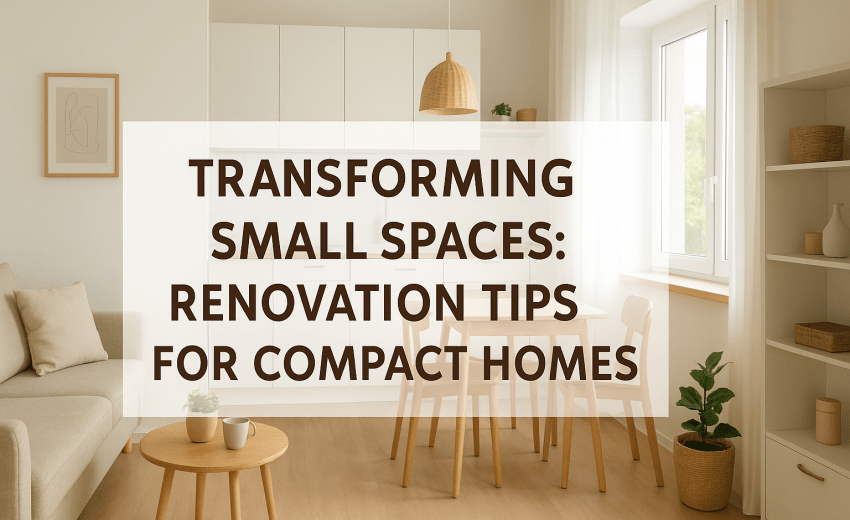
Transforming your compact home into a stylish, comfortable, and practical living space doesn’t require a massive budget or extensive square footage. With smart renovation strategies and creative design ideas, even the smallest of homes can feel open, airy, and well-organized. Transforming a small space is all about blending functionality with aesthetic appeal, ensuring every corner serves a purpose while maintaining a sense of comfort and elegance.
Let’s explore practical renovation tips to help you make the most of your compact home and create a space that feels larger and more inviting.
1. Open Up the Layout
Transforming a confined home begins with rethinking the layout. Knocking down non-structural walls between the kitchen, dining, and living areas can instantly create a sense of openness. Open-plan living enhances natural light flow and makes your home feel more spacious. If removing walls isn’t possible, consider using glass partitions or sliding doors — they maintain separation without sacrificing the feeling of openness.
2. Use Light and Neutral Colors
Color plays a powerful role in transforming how space is perceived. Light and neutral tones such as whites, beiges, and soft greys make a room feel larger and more serene. For added depth, pair these colors with natural textures — like wooden furniture or linen fabrics — to prevent the space from looking too plain. Mirrors are also great tools for reflecting light and visually expanding a room, especially in narrow corridors or living areas.
3. Maximize Storage with Smart Solutions
Transforming a small home into an organized haven means making the most of every inch. Opt for built-in storage solutions that fit seamlessly into walls or under stairs. Floating shelves, multi-purpose furniture (like ottoman benches with storage), and wall-mounted cabinets can declutter your space without consuming valuable floor area. Think vertically — floor-to-ceiling storage not only adds utility but draws the eyes upward, giving the illusion of height.
4. Prioritize Multi-Functional Furniture
When space is limited, furniture must work double duty. Transforming your interior with foldable desks, sofa beds, or extendable dining tables allows you to switch between functions effortlessly. Choose furniture with hidden compartments or designs that can be easily reconfigured. This flexibility ensures your space remains versatile — perfect for both daily use and entertaining guests.
5. Bring in Natural Light
One of the simplest ways to transform a small space is through natural light. Large windows, skylights, and glass doors allow sunlight to flood in, creating a more open and inviting environment. Use sheer curtains instead of heavy drapes to let in light while maintaining privacy. If natural light is limited, combine layered lighting — ambient, task, and accent lights — to brighten up your space and add warmth.
6. Create Visual Continuity
Transforming your compact home also involves maintaining a consistent visual flow. Use the same flooring material throughout your home to create an unbroken line of sight that makes rooms feel connected. Consistency in color palettes, textures, and finishes helps make spaces appear larger and more cohesive. Avoid sharp visual contrasts that can make rooms feel segmented or cluttered.
7. Incorporate Space-Saving Kitchen Designs
Small kitchens can still be functional and stylish with clever design choices. Transforming your kitchen could mean adding open shelving instead of bulky cabinets, using pull-out pantry units, and selecting compact appliances. A rolling kitchen island or a fold-down countertop adds prep space without crowding the area. Keep countertops clutter-free to make the space appear larger and cleaner.
8. Use Mirrors and Reflective Surfaces
Mirrors are a powerful tool in transforming the perception of space. When placed strategically opposite windows or light sources, they bounce light around the room and create the illusion of depth. Glossy finishes on furniture, tiles, or backsplashes also enhance this effect, giving your home a bright, airy vibe.
9. Personalize with Minimal Décor
Transforming a small space doesn’t mean stripping away personality. The key is minimal yet meaningful decoration. Choose a few standout pieces — artwork, plants, or statement lighting — that express your style without cluttering the area. Indoor plants, in particular, bring life and freshness, making even compact spaces feel more vibrant and welcoming.
10. Optimize Outdoor or Balcony Space
If your compact home includes a balcony or terrace, transform it into an extension of your living space. Add foldable furniture, vertical gardens, and soft lighting to create a cozy outdoor retreat. It’s an excellent way to expand usable living space without extensive renovation.
Conclusion
Common renovation mistakes can turn an exciting project into a stressful experience, but with foresight and preparation, they are entirely avoidable. By creating a clear plan, hiring the right professionals, budgeting wisely, and making thoughtful design choices, you can enjoy a smooth renovation journey and achieve results that enhance both comfort and property value.
Ready to Build with Confidence?
Get in touch with Charminar to learn how our project management expertise can streamline your next development.
📧 contact@bluediamondfm.com
📞 +971 56 705 4223
🌐 https://charminardubai.com/
Frequently Asked Questions (FAQ)
How do I make a small room look bigger without major renovations?
You can use light colors, mirrors, minimal furniture, and natural lighting to visually enlarge the space without major changes.
What type of flooring is best for small homes?
Continuous flooring like light-colored tiles, vinyl, or wood helps create a seamless look that makes small spaces appear larger.
Can small spaces still include luxury design elements?
Yes! Opt for premium finishes like marble countertops, brass fixtures, or custom lighting — just ensure they don’t overcrowd the space.
Is it expensive to renovate a small home?
Not necessarily. Since less material is needed, small-space renovations can often be budget-friendly when planned smartly.
What’s the best lighting setup for compact homes?
Layered lighting — a mix of ambient, task, and accent lights — provides both brightness and depth, making small rooms feel spacious.







